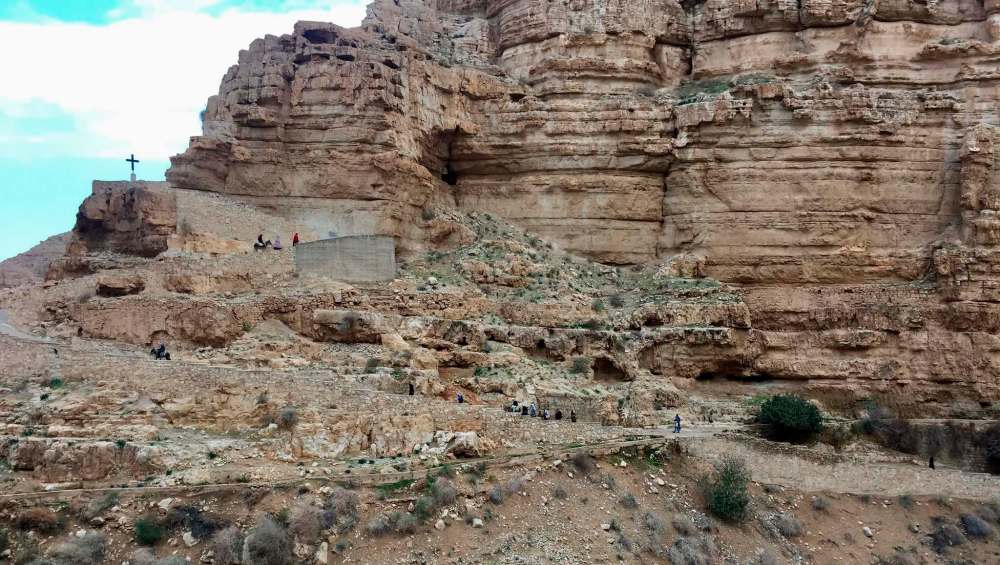Taking a hike of biblical proportions
Trekking through Wadi Qelt a historical and enlightening journey
By: Steve Lyons Posted:Advertisement
Read this article for free:
or
Already have an account? Log in here »
To continue reading, please subscribe:
Monthly Digital Subscription
$19 $0 for the first 4 weeks*
- Enjoy unlimited reading on winnipegfreepress.com
- Read the E-Edition, our digital replica newspaper
- Access News Break, our award-winning app
- Play interactive puzzles
*No charge for four weeks then billed as $19 plus GST every four weeks. Offer only available to new and qualified returning subscribers. Cancel any time.
Read unlimited articles for free today:
or
Already have an account? Log in here »
Hey there, time traveller!
This article was published 02/03/2018 (2492 days ago), so information in it may no longer be current.
It is commonly believed to be the valley of death King David refers to in Psalm 23.
There is an old Roman road that runs parallel to it that is the backdrop for the parable of the Good Samaritan.
It is also said to be the place where the prophet Elijah hid from the forces of Queen Jezebel and was fed by ravens.
At one point in history, King Herod built an aqueduct through it to one of his palaces.
It is a deep ravine that begins at a spring near Jerusalem and runs 15 miles eastward through the Judean Desert to Jericho — where it is said man first came out of caves and formed the first city.
For two millennia, monks, armies and smugglers have used the path as a remote, and sometimes secret, passage between the two cities.
Today, I guess you could call trekking through Wadi Qelt a hike of biblical proportions.
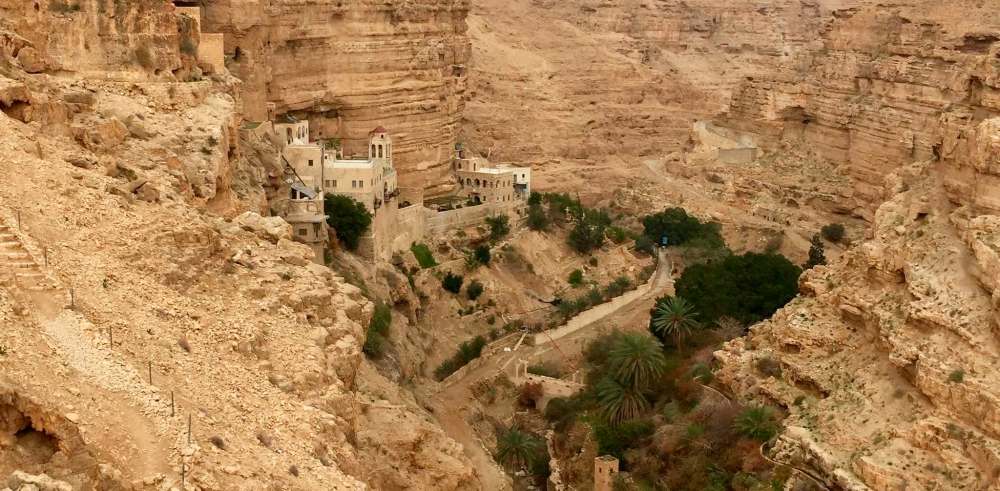
It’s a clear and sunny January day and my guide Hijazi and I — along with his childhood friend Ahmed — have arrived at one of the more popular starting points to walk the wadi. We’re about 20 minutes north of Bethlehem, where I earlier arrived after catching a morning bus near Damascus Gate in Jerusalem.
The first thing I notice as we pull into the parking lot is a camel. And then — I presume — the fellows who own him. Hijazi advises me they are Bedouin, nomadic desert dwellers who have roamed the Middle East and North Africa for hundreds of years. More recently, due to modern governmental policies as well as their desire for an improved standard of living, most have become settled citizens of various nations rather than stateless nomadic herders. Perched near the hike’s start, these Bedouin are offering goods for sale or a camel ride.
Over the course of our trek, we see many more Bedouin, some settled in a variety of makeshift homesteads, some still roaming the desert and shepherding their herds, some offering donkey rides up steep hills and some — youngsters — just laughing and playing.
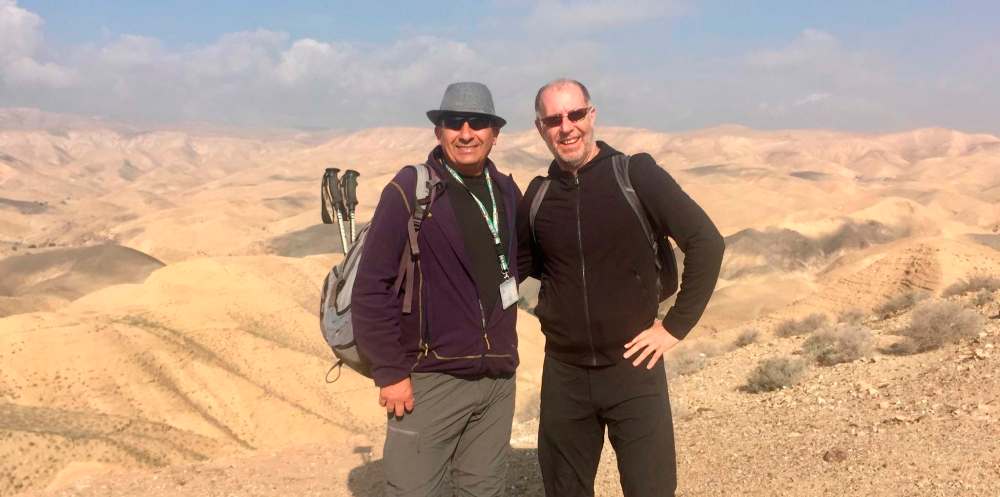
The beautiful path of the wadi offers a spectacular view of the Judean Desert. I have previously hiked in other deserts, but this is a much different experience — I can’t help but feel a sense of awe, a sense of comfort and a feeling of humility as I ponder the immensity and history of this particular stretch of sand.
The landscape is diverse: trees and bushes are permanently green, forming an oasis in the desert valley and along the aqueduct; natural caves and shelters are spread along the wadi and are used by the Bedouin and their livestock; and, before the end of the wadi, Jericho appears as a wide flat plain with a very beautiful natural scene. At one point — from the top of the mountains by the valley gorge — the Dead Sea and most of the Jordan Valley is visible.
It should be noted, the hike traverses a deep chasm that cuts into the rocks, with spring water running all year in the valley below you (wadi means stream in Arabic), making the trail extremely narrow. It’s definitely not for the faint of heart and you should be in decent shape as some of the route is difficult, if not dangerous.
Wadi Qelt is a popular route for Palestinian and Israeli hikers — the area was occupied by Israel after 1967 and hence parts of the wadi were declared the Ein Prat Nature Reserve — and trail markings are quite good. But, being unfamiliar with the territory and wanting to know a little about where I was walking — literally and figuratively — I hired a guide.
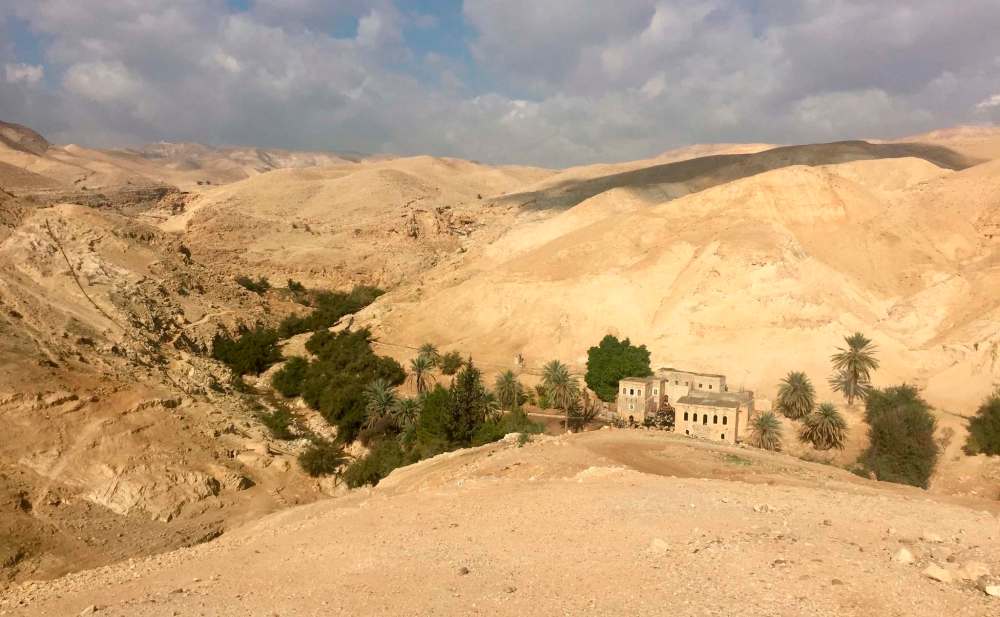
Hijazi Eid is a 52-year-old native of Palestine. He lives in a village named Shyoukh. I ask him how long his family has been there and he answers, "Since forever.”
Abandoning his office job in the 1990s, Hijazi took up a new career as a tour guide. For three years (2008-2011), he was director and helped develop the Masar Ibrahim (masaribrahim.ps) — a 330-km long trail that passes through more than 50 cities and villages in the West Bank and is a portion of Abraham’s Path (abrahampath.org), an initiative to connect, by means of a long-distance path, places associated with the biblical patriarch Abraham. It begins among the ruins of Harran in Turkey, where tradition has it that Abraham, a figure revered in Islam, Judaism and Christianity, first heard the call to “go forth,” and when (and if) it is completed, the route will pass through Syria, Turkey, Jordan, Palestine and Israel.
Over the past several years, Hijazi has been training guides and an increasing number of locals are starting to embrace the idea of exploring and enjoying their own land — and sharing it with internationals. It’s been quite a progression: when he first started recreational hiking, folks in the area thought he was nuts. “What are you doing Hijazi?” he recalls them asking incredulously. The idea of walking from place to place for pleasure was a foreign one to the people of the area. Today, he gets a wave and a warm greeting wherever he goes.
I discovered Hijazi in my quest to find interesting things to do on my visit to Israel — like there’s a shortage of those — when I came across a book by Stefan Szepesi called Walking Palestine: 25 Journeys Into the West Bank.
It wasn’t as easy as I thought it was going to be to find a guide. Jewish guides were either unable to help due to restrictions on their entrance to certain areas or unwilling to help, not wanting to enter the West Bank — even cautioning me against it. One email I received back said: “Nice that you will be visiting Israel in January and thanks for your query. The Wadi Qelt hike can be dangerous — over the years, even over the centuries, it has been a way where people have been ambushed, robbed or even murdered. Right now, tensions are high in the Palestinian areas because of the Trump announcement and I advise to exercise caution in those areas. Especially if you are on your own. You don’t want to be mistaken for an American!”
(In case you missed it, U.S. President Donald Trump made a contentious proclamation in December, recognizing Jerusalem as the official capital of Israel.)
OK, so here’s the recent history: (How do I know? Um, because I checked after that email!): in 1968, an Israeli lieutenant-colonel was killed in action in Wadi Qelt while pursuing Arab militants who had crossed the Jordan. Between 1993 and 1997, Wadi Qelt was the site of several Palestinian attacks on Israeli hikers, with a total of six killings.
A follow-up email to Hijazi about the safety of the hike was much more assuring: “Regarding the situation here, the media focus on a small event here or there and make it a big story! (I’ve heard that one before).
"Let me tell you, it is very safe and secure regardless of Trump’s statement. I am sure you will be safe with us. The safety of our guests is our priority!”
I learn many things from Hijazi over our time together — we also spent a day together touring Bethlehem — and of course, the Palestinian-Israeli conflict came up in our discussions. I won’t go into details, only to say I have a more well-rounded understanding of the situation today than what I had prior to my trip the area.
What I learn most about Hijazi over my time with him though is he has a deep love for his homeland: its people, its culture and its land. He also has an intimate understanding and knowledge of its history and has a strong belief that travel encourages tolerance and breaks down prejudice. I can attest to that.
He has numerous multiple-day walks (hijazih.wordpress.com) scheduled for later this month, April, May and June — with various itineraries that include cities like Bethlehem, Nablus, Jericho, Hebron and parts of the Masar Ibrahim. Accommodations are offered in Palestinian homes and Bedouin tents, providing guests with the opportunity to experience local life and enjoy traditional Palestinian food and hospitality.
He is also organizing the Palestine Peace Walk (March 30-April 10) that starts in Jerusalem with a visit to the Al-Aqsa Mosque, the Via Delarosa and the Holy Sepulchre Church before winding its way through West Bank communities such as Nablus, Awarta, Kefer Melek, Jericho and Hebron before finishing in Bethlehem.
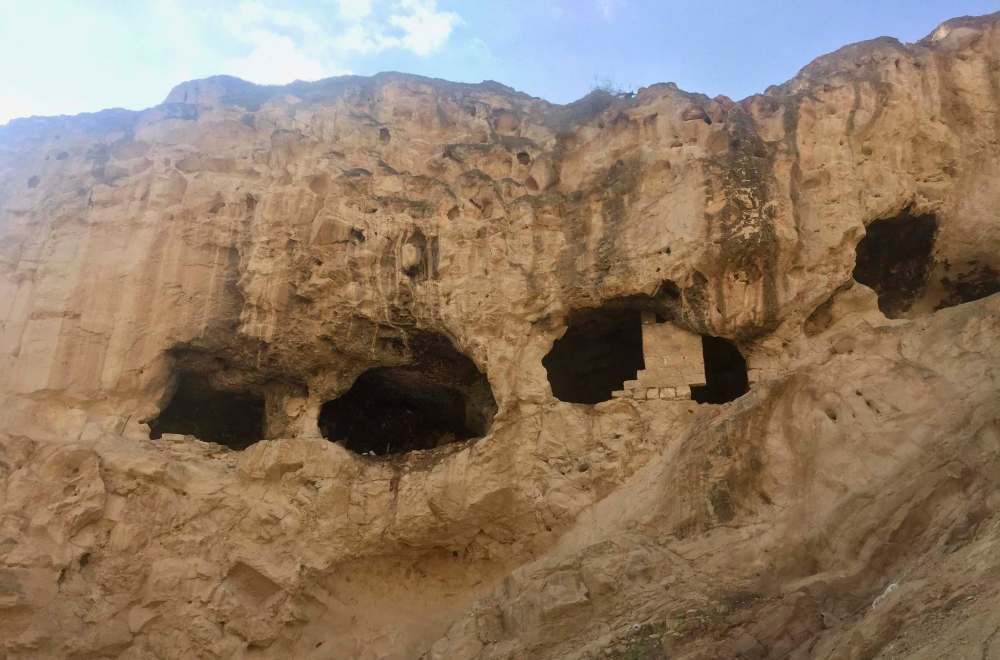
A couple of hours into our hike — after our snack of figs and oranges — I inquire with Hijazi how far until we reach the monastery.
The Monastery of Saint George is one of the destinations that originally drew me to the idea of visiting Wadi Qelt. I often seek out noteworthy monasteries when I travel — perhaps it’s the quest for peace and quiet.
Founded by 4th-century hermits from Syria wanting to imitate the prophet Elijah’s cave experiences with the ravens, Saint George became an important spiritual centre in the sixth century. Hermits living in caves in nearby cliffs would meet in the monastery for a weekly mass and communal meal.
The monastery went through the phases of destruction in the 7th century by the Persians (who martyred all 14 resident monks), rebuilding in the 12th century by the Crusaders, then disuse after the Crusaders were expelled from the Holy Land. Complete restoration was undertaken by a Greek monk, Callinicos, between 1878 and 1901.
It is well known for its hospitality and, unlike most Greek Orthodox monasteries, welcomes female pilgrims and visitors — following a precedent set when a Byzantine noblewoman claimed the Virgin Mary had directed her there for healing from an incurable illness.
We arrived at the complex from the winding path through the wadi, but you can also reach the monastery from a new road that was built in 2010 that connects to the old Roman road that is still used by cars and tour buses. From there, visitors must walk down a steep and winding path for about 15 minutes to reach the monastery. The walk back up is a challenging one, or you can hire a donkey ride from one of the local Bedouin, who are on hand pitching their assistance.
The monastery is a quiet, peaceful spot that encourages one to pause and reflect; a group of pilgrims from Romania are being led by their priest in a small service and Hijazi, a devout Muslim, also takes time for one of his daily prayers.
The cliff-hanging complex carved into a sheer rock wall overlooking a lush garden with olive and cypress trees was one of the most striking sights I saw during my visit to the Holy Land.
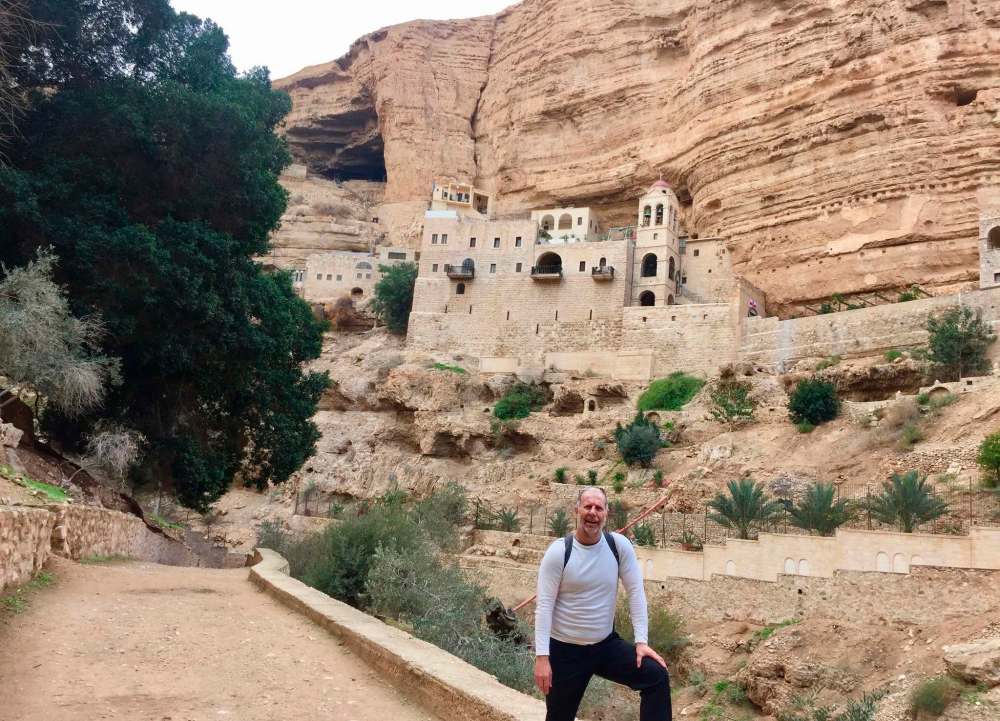
After ascending the steep path back to the old road — sans donkey ride I might add — we are about to embark on the final leg of our walk down to Jericho, which sits 846 feet below sea level.
Perhaps best known for its biblical history, the city’s site is also of great archaeological importance, providing evidence of the first development of permanent settlements and the first steps toward civilization.
Archaeologists have unearthed the remains of more than 20 successive settlements in Jericho, the first of which dates back 11,000 years (9000 BC). It is believed to be one of the oldest inhabited cities in the world, along with Damascus and Aleppo in Syria.
Excavated remains of the ancient settlements of Jericho can be explored at Tell es-Sultan archaeological park. Be sure to view the very informative 15-minute multi-media presentation on the area just inside the entrance gates.
Jericho is perhaps best known for its biblical history.
According to the Book of Joshua, the Battle of Jericho was the first battle of the Israelites in their conquest of Canaan. The Bible says the Israelites marched around the city for seven days and on the last day, the priests blew their trumpets, the people shouted and the walls fell;
Christian Gospels state that Jesus of Nazareth passed through Jericho where he healed blind beggars and inspired a local chief tax-collector named Zacchaeus to repent of his dishonest practices
The cable car running up to the top of the Mount of Temptation — said to be the hill in the Judean Desert where Jesus was tempted by the devil — is the city’s stand-out attraction. It offers stunning views of and on top of the mountain sits the elegant Greek Orthodox Monastery of Temptation, which is cut miraculously into the hillside like the previously mentioned Monastery of Saint George.
More recently, Jericho was one of the first of the cities and towns evacuated by Israeli forces and turned over to Palestinian administration in the wake of the 1993 Oslo Accords.
Our walk ends at a welcoming restaurant in the centre of the new city. Hijazi, Ahmed and myself break bread; share a number of local specialities; and then sip tea to people watch and chat about the day and the area. I am reminded of something I read on Hijazi’s website that says the best way to know the country and its people is to explore it by foot.
Indeed.
